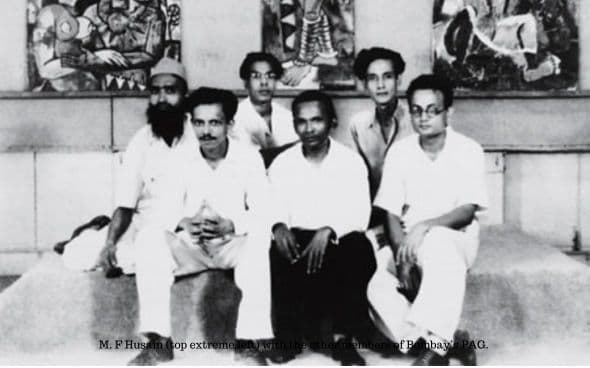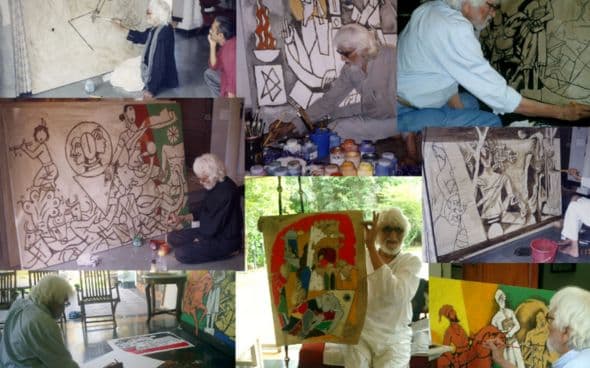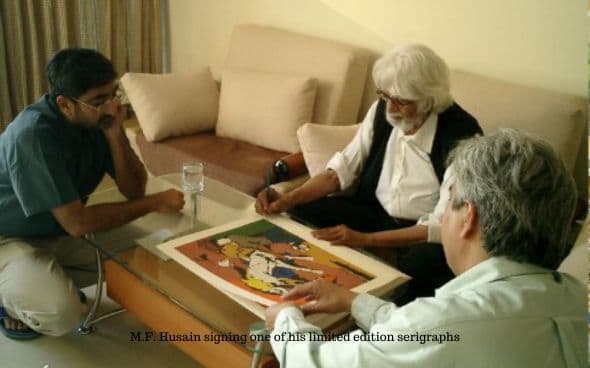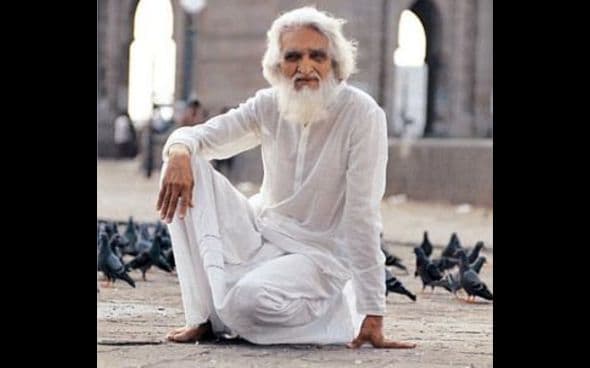Hello! We've made some recent changes to our website. If you face any issues please reach out to us on +91-8088313131 or on experience@artflute.com
Reach out to us on +91-8088-313131 or experience@artflute.com if you face any issues.


M.F. Husain

M.F. Husain
Contemporary Artist
![[object Object]](/_next/static/media/profilearrow.f3172fa3.svg)
About Artist
M.F. Husain, a pioneer of Indian art, fused traditional and contemporary elements to create captivating paintings. His bold strokes and expressive lines, combined with vibrant colors, imbue his subjects with dynamic energy. Drawing inspiration from Indian folklore, mythology, and modern culture, Husain's works transcend time. His unique style, with a touch of cubism, leaves an indelible impression...Read More
In addition to his paintings, Husain ventured into filmmaking, receiving acclaim for his movies, including "Through the Eyes of a Painter" and "Gajagamini." Recognized for his contributions, he received prestigious honors such as the Padma Bhushan and Padma Vibhushan from the Indian government. Throughout his seven-decade career, Husain broke new ground, pushing the boundaries of Indian art and inspiring future generations. In 2011, the art world mourned the loss of M.F. Husain as he passed away in London, leaving behind a legacy of captivating and visionary art. Browse through the individual series of Husain's serigraphs here:
Horses by Husain
Theorama Series by Husain
The British Raj by Husain
Mother Theresa by Husain
M.F. Husain: The Visionary Who Redefined Indian Modern Art
M.F. Husain, one of India’s most celebrated artists, seamlessly blended tradition and modernism throughout his career. Awarded the Padma Bhushan and Padma Vibhushan, his legacy transcended the confines of galleries, spanning thousands of paintings, films, and serigraphs. Husain’s work, influenced by Indian history, mythology, and society, often explored themes of rural life, mythology, and the female form, reflecting a deep connection to India’s identity. Despite facing controversy and exile, his art, marked by boldness and innovation, continues to resonate globally. Husain’s fearless pursuit of artistic freedom and his ability to merge tradition with contemporary themes have left an indelible mark on the art world.

Introduction: The Master of Bold Expression
Maqbool Fida Husain, a 20th-century Indian artist and a poet, who blended art and modernism, rose to become one of the nation's most recognizable artistic figures. His vibrant paintings, bursting with colour and bold shapes, explored themes from Indian history, mythology, and even pop culture. As a founding member of the Bombay Progressive Artists' Group (PAG), Husain pioneered a unique style, adapting the European Cubist movement to Indian subjects. He worked across various mediums, from traditional oil, acrylic, and watercolors to more contemporary techniques like offset printing and serigraphy.

Early Life & Cultural Influences: The Making of a Visionary
Born around 1915 in Pandharpur, Maharashtra, having lost his mother during his infancy, he was sent to his grandfather's Madrasa in Gujarat on that account. His early exposure to Urdu language and literature is where he developed a deep interest in the geometric forms of Kufic calligraphy. Later on, his family moved to Indore, where he developed quite a liking for Hindu Mythology as he was exposed to RamLeela performances (which enact scenes from deity Ram's life). It was there that he took an interest in poetry as well which led him to participate in evening Mushairas or poetry recital contests.

Celebrating India's Culture and Mythology
M.F. Husain's deep love for India is evident throughout his career. His paintings are a treasure trove of Indian subjects and symbols, reflecting his fascination with the country's political landscape, rich history, captivating mythology, diverse people, and vibrant cultures. In the years following India's independence, Husain turned his focus to the nation's foundation, depicting rural life, hardworking farmers, and motifs like horses and wheels. Paintings like "Peasant Couple" (1950) and "Zamin" (1955) exemplify this period. He also skillfully blended his appreciation for Rajasthani miniatures with the starker realities of contemporary urban India, as seen in "Amusement in the Street" (1957). Notably, the female form was a recurring theme in Husain's work. He explored women in various contexts - from domesticity to epic figures and goddesses - often imbuing them with a sense of power ("shakti") as reflected in works like "Durga" (1964) and "Draupadi" (1971).

Husain's Creative Vision
M.F. Husain's artistic expression transcended the confines of galleries. A prolific creator, he produced thousands of paintings and even ventured into filmmaking. His 1967 short film, "Through the Eyes of a Painter," garnered international acclaim. His later films explored strong female characters, reflecting a recurring theme in his art. However, his artistic freedom faced challenges. As Hindu fundamentalists gained traction, his depictions of deities sparked controversy. Facing legal battles, vandalism, and government indifference, Husain went into exile in 2006. Despite the turmoil, his artistic legacy remains secure, with his works displayed in prestigious collections worldwide.

Crafting Legacy Through Serigraphs
M.F. Husain signing one of his limited edition serigraphs

A Trailblazer Whose Art Transcended Time
M.F. Husain, a man draped in the twin honors of the Padma Bhushan and Padma Vibhushan. Given the misfortunes he faced in his final years, he left no stone unturned until the very end to keep his legacy alive. The impact of his artistic output echoed far beyond the years he spent creating them. Each Husain painting whispered tales of unparalleled talent, a relentless spirit of innovation, and an unwavering devotion to the unfettered expression of art. His legacy, symbolizing a chariot of the spirit of Indian identity. He wasn't afraid to reach back into tradition, pulling its essence forward to meet the contemporary world in a dazzling confluence. Yet, his gaze was never solely turned inward. Husain held a mirror to society, reflecting its complexities and challenges with unflinching honesty. A pioneer, indeed, for he didn't just paint; he celebrated, he merged, and he challenged, leaving the art world forever marked by his commendable artistry.

















